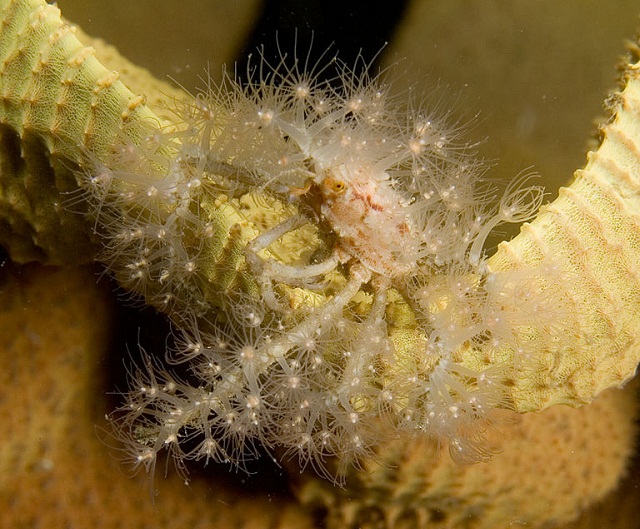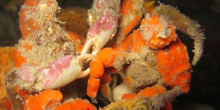
Sarah Bedolfe
These crab species collect things from their environment to use as camouflage and defense from predators.
Featuring one amazing marine animal per week.
Decorator crabs collect things from their environment and stick them on their bodies. They’re also known as dresser crabs. Carrying objects around this way offers protection and camouflage for these little animals.
Decorator crabs aren’t a single species. Instead the name refers to the group of crab species in the superfamily Majoidea that engage in this behavior.

This crab is hiding under a coat of bryozoans. It's also got a couple of tunicates on its legs. Photo by Ed Bierman via Flickr, Creative Commons License.
Different species have different specialties. The little seaweed crab (Naxia tumida) of Australia specializes in picking algae off the rocks it lives on and attaching them to its shell, or carapace. Other crabs have different ways of selecting items with which to “decorate.” Some are more aggressive – instead of decorating with things that will camouflage them, they may choose something that stands out but will protect them – such as an anemone or coral polyp that will sting anything that comes too close, or a spiky urchin.
Sponge crabs, as you would expect, decorate with pieces of sponge, which has two purposes: as long as the crab lives on that sponge they are camouflaged, and since many sponges are toxic they also offer extra protection from bigger things that may attempt to eat the crab. A crab placed in a new environment will select different items from that environment in order to fit in.

Two decorator crabs bedecked in pieces of sponge. Photo by Richard Ling via Wikimedia Commons, Creative Commons License.
The crabs have little bristles on their carapaces that are hooked and act like Velcro, making their selections stick. Some species also secrete a special adhesive.
Decorator crabs have also been seen cutting and trimming their items to fit perfectly on their shells. As a crab grows, it must molt its old shell and grow a new, bigger one, and crabs have been observed “recycling” the items from their old shell and adding them to the new one.

A multitude of hydroid polyps protects this crab. Photo by Nick Hobgood via Wikimedia Commons, Creative Commons License.




